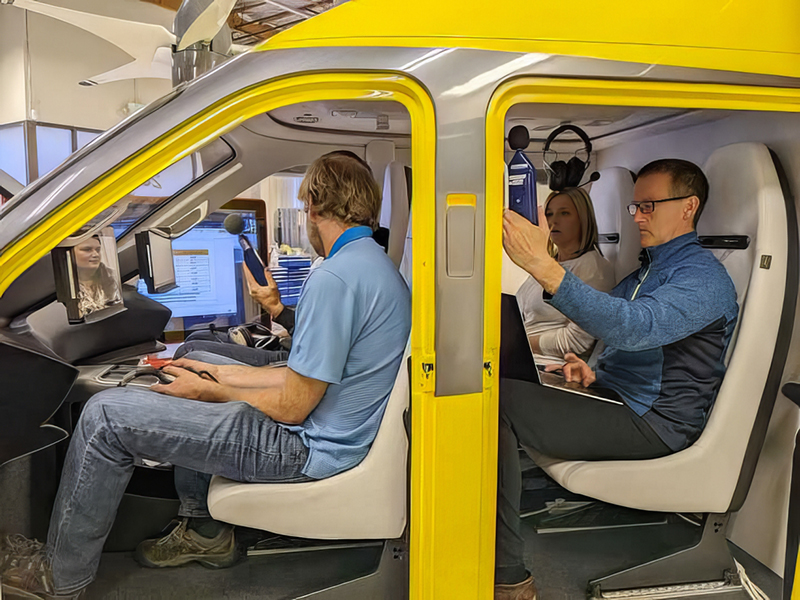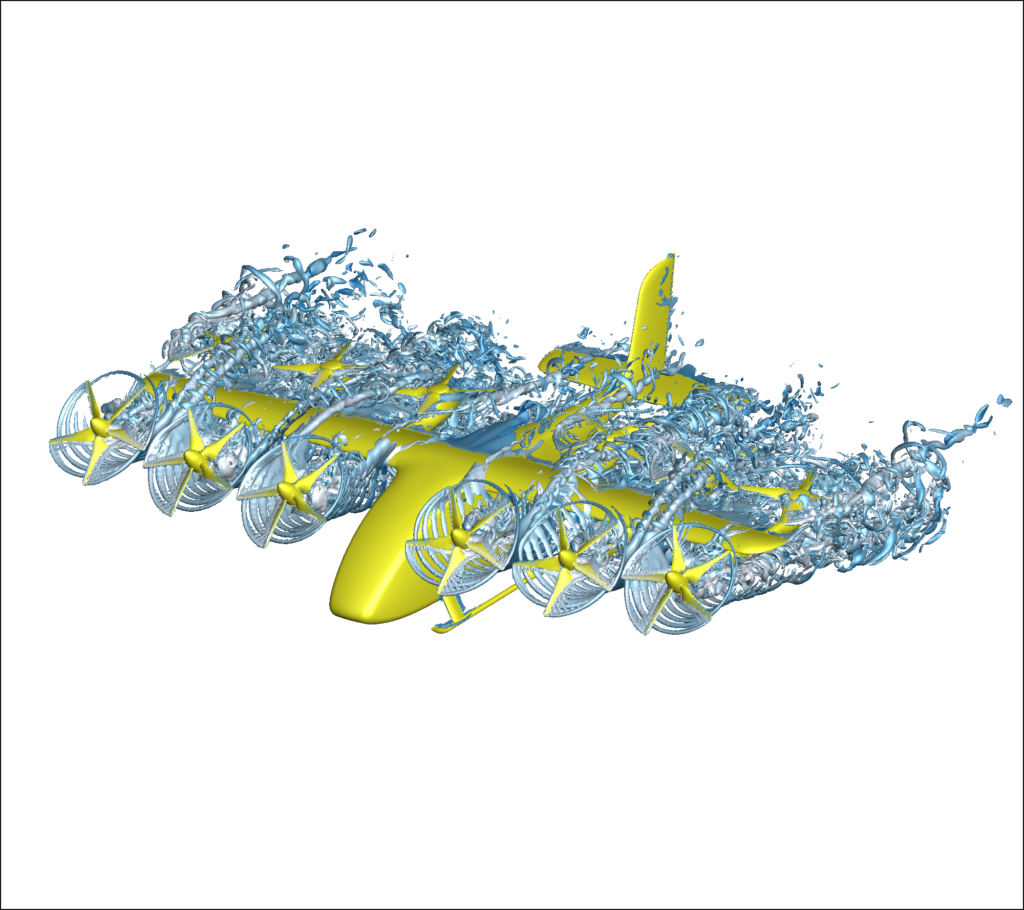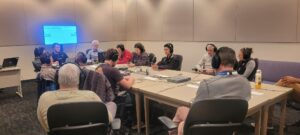Situated inside the design studio of our Mountain View Headquarters, this Gen 6 cabin model was never intended to fly. Instead, its purpose is to help us build the best passenger experience possible, including our in-cabin noise testing.

One broad appeal of Urban Air Mobility (UAM) is that eVTOLs make less noise than traditional aircraft. Noise can have both positive and negative impacts on human health. Predicting and understanding in-cabin and external-cabin noise for eVTOLs is of great importance as the industry prepares to launch commercial services across the world. Wisk has researched both internal and external noise, and this article will focus on how in-cabin noise testing was conducted. External noise testing, and the results of that testing, will be covered in another article.
Creating an Accurate Noise Profile
Quieter doesn’t mean silent. Understanding the impact of noise is crucial for Urban Air Mobility (UAM) producers and operators. While these aircraft are still in development, it’s important to have an idea of their noise profiles to avoid costly and time-consuming design changes later on.
Simulation plays a vital role in this process. Wisk’s Senior Staff Aerodynamic Engineer, Sebastian Thomas, explained that, “By combining teamwork, cutting-edge technology, and some pretty advanced mathematics, we have a pretty good idea of what our Gen 6 aircraft will sound like.”
It all starts with taking the data generated by computational fluid dynamics models of the aircraft. Neel Vora, the Sr Staff Aerospace Engineer at Wisk, noted that “The CFD (computational fluid dynamics) data is the backbone of this pipeline and our decision to rely on high fidelity, fully coupled simulations has been key to matching experimental data and making realistic predictions.” This data is then processed through industry-standard modeling toolchains to simulate a noise footprint for our Gen 6 aircraft.

Unsteady computational fluid dynamics was used to simulate the aircraft in various phases of flight. This data served as the foundation for developing an accurate noise profile.
It was, of course, necessary to verify the accuracy of this model. To do this, Wisk engineers drew upon the knowledge gained from Wisk’s five previous generations of aircraft. Using the model, we created a simulated noise file for our 5th-generation aircraft, Cora. We then compared the simulated file against a real-life comprehensive acoustic and vibration survey conducted over a number of Cora’s almost 1500 test flights. The two profiles were in both qualitative and quantitative agreement.
Armed with a validated noise modeling program, we have already reduced our noise footprint, even before the Gen 6 flies for the first time. Simulation-informed design changes include altering the distance between the rotors and the booms to reduce acoustic interference and altering the direction of fan rotation and orientation to direct noise away from the passenger cabin.
All updates to the Gen 6’s design are now run through the acoustic simulation to determine the potential impact on passenger comfort.
With a validated model, Wisk engineers are now equipped and ready to conduct testing to better understand how aircraft noise will impact our passengers.
Ensuring Passenger Safety and Comfort
When it comes to noise, it’s not just about loudness (dBA). Other factors like duration, harshness, and frequency can also influence a passenger’s experience. This means that two noises could be identical in terms of decibels, for example, a violin and an electric drill, but one is subjectively perceived as more aggravating due to its relative sharpness, strength, roughness, or frequency. As noted in a recent noise study, “The overall sound quality of noise, whether pleasant or annoying, is judged by the listener.” Along a similar vein, noise context is also important. Transitioning from a silent room to common airliner cabin noise in cruise is initially perceived as quite uncomfortable. However, anyone who has taken a commercial fight recognizes that one quickly becomes accustomed to this new noise baseline and no longer finds it highly disruptive.
As a new industry, we are still exploring how different aspects of the noise profile impact passenger comfort. Lauren Butt, a Loads and Dynamics Engineer working on our Gen 6 aircraft, notes that “We have focused on both safety and comfort. There is no question that it is safe for people to be on the aircraft, however, psychoacoustics focuses on passenger comfort.”
Achieving passenger comfort is a complex problem, given that there are no clear comfort standards and comfort is quantitative and perception based. What may be comfortable and acceptable to one person may be uncomfortable and unacceptable to another.
To gain insights into the impact of noise on passenger comfort for our Gen 6 aircraft, Wisk’s Acoustics & Vibration (A&V) Working Group conducted a special study focusing on Cabin Noise.
Through our work with Boeing, we were able to conduct testing at Boeing’s Acoustics, Noise, and Propulsion Lab (ANP Lab), which is part of Boeing’s Critical Listening Facility (CLF).

Participants in our noise testing trials at Boeing Noise Lab’s Critical Listening Facility.
“We knew our aircraft was going to sound different from anything out there, and we wanted to understand how that would impact customer comfort levels.” – Lauren Butt, Loads and Dynamics Engineer
Our study focused on passenger comfort by isolating the negative impacts of loudness (dBA), frequency variations (sharpness and roughness), length of flight segments, and the ability to hear speech.
Testing involved 48 participants listening to seven simulated flight conditions. Participants were equally divided by age and gender and provided a good representation of a wide range of travelers with different auditory capabilities and perceptions.
Participants provided real-time feedback on their perceptions of noise and associated annoyance levels. Correlations like these were extracted from the A&V survey data and used to create an acoustic annoyance model, which in turn guides the setting of cabin acoustic requirements.
We will continue to work on further reducing in-cabin noise for even more passenger comfort. Of equal importance, we will soon be conducting tests on external aircraft noise. These tests will use the same noise profile and focus on how this noise can and will impact community acceptance of AAM. Keep an eye out for more information on external noise testing later this year.